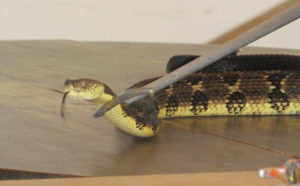By David Cederstrom, Chronicle Staff Writer
The PowerPoint presentation went awry at the Lake George Land Conservancy in Bolton Landing on Aug. 16, so biologist Dr. Bill Brown instead brought in a live rattlesnake from his lab at the Darrin Fresh Water Institute for his talk.
This turn of events actually pleased the 40-person audience, although a few people in the front row did vacate their chairs and move farther back when Dr. Brown released the snake onto a table a few feet away at the front of the room.
He used a long-handled tool to gently prevent the animal from escaping off the table. The snake produced a loud buzz with the rattle at the end of its tail at first, but settled down after a while.
Rattlesnakes can continue to rattle for hours if forced to, Dr. Brown said.
Dr. Brown, of Fort Ann, has been studying for some 38 years the timber rattlesnakes found around The Narrows area of Lake George.

He said a full-grown timber rattlesnake, Crotalus horridus, can carry on a normal rattlesnake life eating only “half a dozen chipmunks, maybe 10 chipmunks” per year or “maybe a few dozen mice.”
Snake captured on shore that day
The rattler he brought into the talk was captured that afternoon by Department of Environmental Conservation Forest Rangers at Black Mountain Point on the east shore. He said it would soon be released back into the wild after being measured and marked for future identification.
Dr. Brown weighed the snake, one of the measurements he takes for his study. It came in at about 1500 grams (3.3 pounds).
Asked how long rattlesnakes live, Dr. Brown said they average 25 to 30 years, with some reaching about 40. However, he said he was surprised last year to find a female who was over 50.
The timber rattlesnake was once considered vermin and many populations, including those in Saratoga and Schenectady Counties, were extirpated by humans.
Rattlesnakes are now protected as a “Threatened” species in New York. Dr. Brown said that slightly more than 200 populations still exist statewide, “in about two dozen counties, including Essex, Warren, and Washington, [and] Montgomery,…and they are pretty widely distributed in Orange, Rockland, Sullivan, Delaware, and Ulster.” They also live in other states from New England to Texas.
Can stay motionless for days
Timber rattlesnakes are “sit-and-wait ambush predators” that can stay motionless in one spot for as long as a couple of days waiting for small animals such as mice, chipmunks, voles, red squirrels and occasionally birds to come within reach, Dr. Brown said.

A full-grown adult is capable of eating a gray squirrel, but gray squirrels are rare in their habitat in this area, he said.
Dr. Brown said that after biting an animal and injecting it with venom, rattlesnakes will typically release the animal and wait for the venom to kill it, but that they will hang on to birds. He called this an evolutionary adaptation to the fact that a bird might fly away before succumbing.
Timber rattlesnake venom is in the midrange of toxicity among the dozen rattlesnake species found in the United States, Dr. Brown said. He said Eastern diamondback rattlesnakes in the Southeast and the Mojave rattlesnake in Arizona, Utah and California have the most potent venom.
‘If bitten, use your car keys’
Timber rattlesnakes “are not aggressive” and will avoid humans if possible rather than bite them, but if you are bitten, the most important tool is your car keys, so you can drive to the hospital and be treated with antivenom, Dr. Brown said.
Forget about making incisions to release the venom, or using ice packs or tourniquets, he said. “The most effective snakebite treatment is get to the hospital.”
He said the bite is extremely painful and will cause a great deal of swelling.
In rare cases a person may have an extreme allergic shock reaction to the venom, in which case rapid treatment becomes urgent, but Dr. Brown said that otherwise you have hours to get to the hospital.
A person might even survive a rattlesnake bite without any treatment, but recovery could take a very painful couple of weeks, he said.
Copyright © 2017 Lone Oak Publishing Co., Inc. All Rights Reserved.
 Glens Falls Chronicle Serving the Glens Falls/Lake George region; Warren, Washington and northern Saratoga counties since 1980
Glens Falls Chronicle Serving the Glens Falls/Lake George region; Warren, Washington and northern Saratoga counties since 1980

